|
|
|
1.
|
Which triangle is a translation toward
the origin
of triangle CDE? | 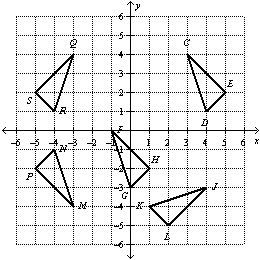 | | |
A) | DJKL | B) | DMNP | C) | DFGH | D) | DQRS |
|
|
|
2.
|
Which line of reflection maps point F at  to point F’
at  ? A) | y = –2 | B) | y = -x | C) | y = x | D) | x-axis |
|
|
|
3.
|
Triangle F' G' H' is a transformation of triangle FGH.
If  F', F',  G', and G', and  H', H',  F'G'H' is a: F'G'H' is a: | 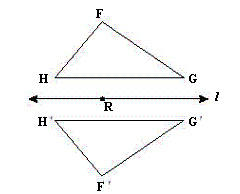 | | |
A) | reflection of DFGH across the line
l | C) | translation of DFGH across the line
l | B) | 180° rotation of DFGH
about point R | D) | 90° rotation of DFGH
across the line l |
|
|
|
4.
|
If triangle KLM is reflected across the y-axis to form triangle K’L’M’, what is the coordinate
of K' ?
| 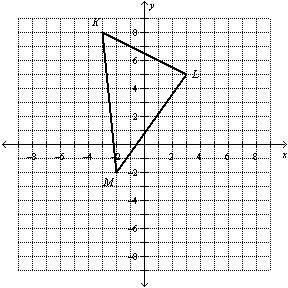 | | |
A) | (8, –3) | B) | (3, 8) | C) | (3, –8) | D) | (–3,
–8) |
|
|
|
5.
|
Triangle E’F’G’ is apparently: A) | a translation across the x-axis of triangle EFG | B) | reflection across
the x-axis of triangle EFG | C) | a 90° clockwise rotation about the origin
of triangle EFG | D) | reflection across the y-axis of triangle
EFG |
|
|
|
6.
|
How many different lines of symmetry does a regular hexagon
have?
|
|
|
7.
|
In the design, a hexagon is inscribed in a circle.
Which point shows
the location of Point S after a 180° clockwise rotation around the center? | 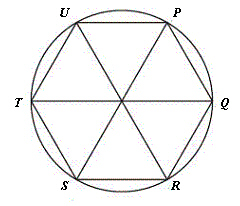 | | |
|
|
|
8.
|
Quadrilateral JKLM is symmetric with
respect to the y axis.
If the coordinates of K are
(6, 1), what are the coordinates of M? | 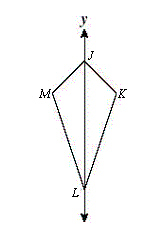 | | |
A) | (–6, –1) | B) | (–1, –6) | C) | (–6, 1) | D) | (–1,
6) |
|
|
|
9.
|
Which is most likely a | line of symmetry for
triangle RST ? | 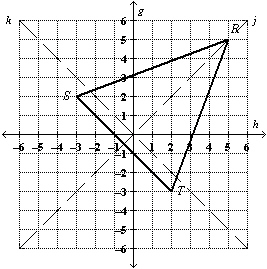 | | |
|
|
|
10.
|
Quadrilateral WSJC is shown.
If WSJC is reflected across the line  , what are the coordinates of J’ ? , what are the coordinates of J’ ? | 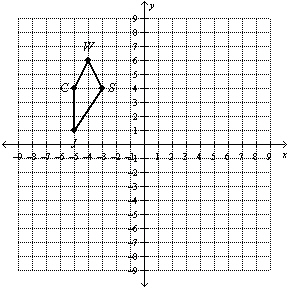 | | |
|
|
|
11.
|
All the vertices of the hexagon have
integral coordinates.
One
of the lines of symmetry for the hexagon goes through: | 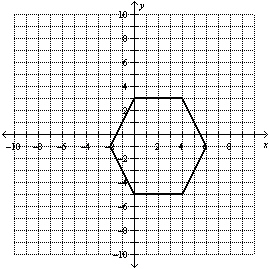 | | |
A) | (0, –5) and (4, 3) | C) | (4, 4) and (4,
–5) | B) | (3, 3) and (3, –5) | D) | (2, 3) and (2, –5) |
|
|
|
12.
|
When tiles fail to tesselate in a plane and have an overlap, what is true about
the angle measure sum of the tiles surrounding a single point?
A) | >90° | B) | >180° | C) | >360° | D) | >320° |
|
|
|
13.
|
Which of the following letters has neither vertical or horizontal line
symmetry?
E Z H B
|
|
|
14.
|
 UVW UVW was obtained from  RST RST by rotation about the point H.
Which of the following indicates
the correspondence of the vertices? |  | | |
A) | R ® U, S ® V, T ®
W | C) | R ® U, S ® W, T ®
V | B) | R ® V, S ® W, T ®
U | D) | R
® W, S ®
U, T ®
V |
|
|
|
15.
|
Rectangle JKLM is placed in a
coordinate plane as shown.
Which equation describes a
line of symmetry
for rectangle JKLM ? | 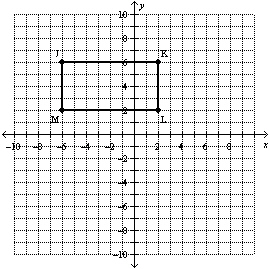 | | |
A) | x = 4 | B) | y = –2 | C) | x = –2 | D) | y =
x |
|
|
|
16.
|
The polygon A’B’C’D’E’ is 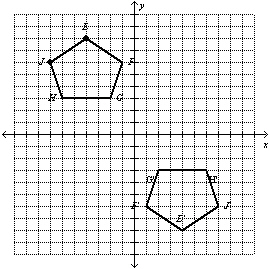 A) | a reflection of EFGHJ across the y-axis | C) | a translation of EFGHJ across the
x-axis | B) | a reflection of EFGHJ across the x-axis | D) | a reflection across the
orgin |
|
|
|
17.
|
Issabelle is looking at plate designs. Which design has exactly 4 lines of
symmetry?
|
|
|
18.
|
In relation the figure in the second quadrant, the other figure is apparently a
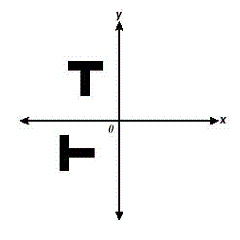
A) | reflection across the y-axis | B) | reflection across the
x-axis | C) | translation across the x-axis | D) | 90° counter-clockwise rotation about the
origin |
|
|
|
19.
|
A) | (2, –1) | B) | (1, –2) | C) | (1,
2) | D) | (–1,
–2) |
|
|
|
20.
|
This figure is apparently | symmetric with respect to: | 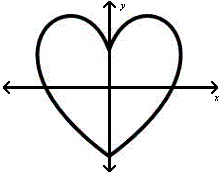 | | |
A) | the x-axis only | C) | both the x-axis and the y-axis | B) | the y-axis
only | D) | neither the x-axis nor
the y-axis |
|
|
|
21.
|
Which transformation could move the | triangle H to triangle H’ in a single step? | 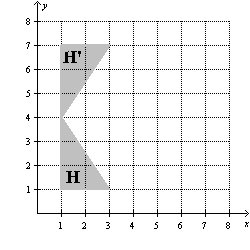 | | |
A) | Reflection over x = 4 | C) | Translation | B) | Rotation about (2,3) | D) | Reflection over y =
4 |
|
|
|
22.
|
Given: Triangle WKP with vertices
located at W(7, 1), K(4, 2), and
P(–5, –1). Triangle WKP will be reflected over the line
 . What will be the integral coordinates of point W' after this
transformation?
|
|
|
23.
|
Figure STARFIND is symmetric with
respect to the x-axis. The coordinates of point T are (8, 5).
What are the coordinates of point
D ? | 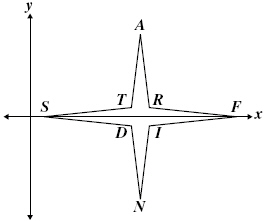 | | |
|
|
|
24.
|
The hexagon in the drawing | has
a line of symmetry through: | 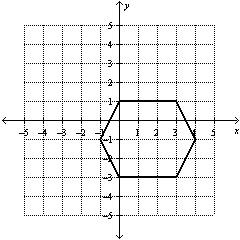 | | |
A) | (0, –3) and (3, 1) | C) | (3, 2) and (3,
–3) | B) | (2, 1) and (2, –3) | D) | (–1, –1) and (4, –1) |
|
|
|
25.
|
Triangle RST was transformed into
Triangle R´S´T´.
Which term
most accurately describes the transformation? | 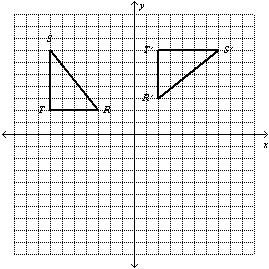 | | |
A) | Rotation | B) | Reflection | C) | Tessellation | D) | Translation |
|